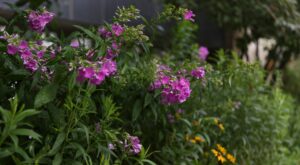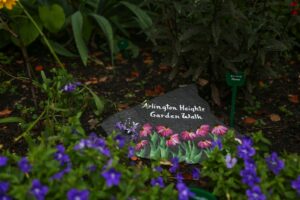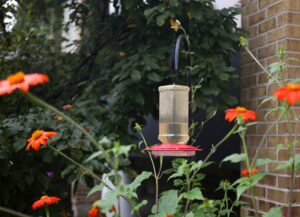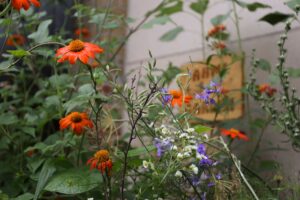Have you heard the buzz around the Arlington Heights Memorial Library this summer? Its butterfly garden, located near the library’s front entrance on Dunton Avenue, has been drawing lots of pollinators, hummingbirds and yes, butterflies.

Volunteer gardeners include: Mary Weber, Linda Nitch, Terri Webster, Shelley Plischke and Janet Landeweer. (Photos by William Tolan)
In fact, the staff of library volunteers who tend the flowers were pleased that the garden earned recognition as a Monarch Waystation, by the Monarch Watch project at the University of Kansas.
The project supports a network of more than 50,000 Monarch Waystations around the world. They provide critical resources for monarchs — which are considered to be endangered — throughout their annual cycle of reproduction and migration, while supporting other pollinators and wildlife.
Lucy Sears is a readers’ advisor in the library’s Info Services. She and other staff members gravitated toward each other with their mutual love of gardening. And, as it turns out, many of them were working to protect monarchs in their own backyards.
“It seemed to be a natural extension to find out if the library would allow a group of staff members to create an inviting, colorful natural space near the benches on Dunton Avenue,” Sears says.
They’ve been working on the garden since 2020, thanks to a grant from the Friends of the Library and approval from library officials, from the director on down.
“The butterfly garden reflects the library’s mission,” says Deputy Director Dana Revilla, “by creating a space where people of all ages can connect with nature, learn something new, and enjoy a moment of peace.
“We’re looking to expand these kinds of spaces around our Makerspace and other areas of the library,” Revilla adds, “because we recognize how valuable these small moments of connection and discovery can be throughout our library grounds.”
The garden is no small endeavor. While the butterfly habitat always has common milkweed and butterfly weed grown specifically for monarchs, and some dill, which is a host plant for Black Swallowtail caterpillars, many other plants make the garden stand out.
The gardeners always strive for brilliant color, consequently, this summer they’re growing blackeyed susan, black and blue salvia — a hummingbird attractor — as well as tithonia, zinnias, sunflowers, coneflowers, shasta daisies, phlox, lanceleaf coreopsis, cardinal flowers, lantana, browalia, New Guinea impatiens and Mexican heather, to name just a few.
The butterfly garden and its Monarch Waystation designation drew the attention of the Arlington Heights Garden Club, whose members invited the library to be featured in its Garden Walk earlier this summer. Once again, these library staff members turned gardeners looked at it as a learning opportunity.
They manned a booth to answer questions from Garden Walk visitors and they provided a handout listing the plants which are currently in the garden.
“Our goal was always to create a natural habitat for butterflies, pollinators and hummingbirds that provides shelter and food throughout the growing season,” Sears says, “and to grow plants that do well within our climate.”
Of course they encourage anyone who is inspired by the garden to go inside the library to look for books on gardening specific to Illinois and for attracting hummingbirds and butterflies to their own garden.




